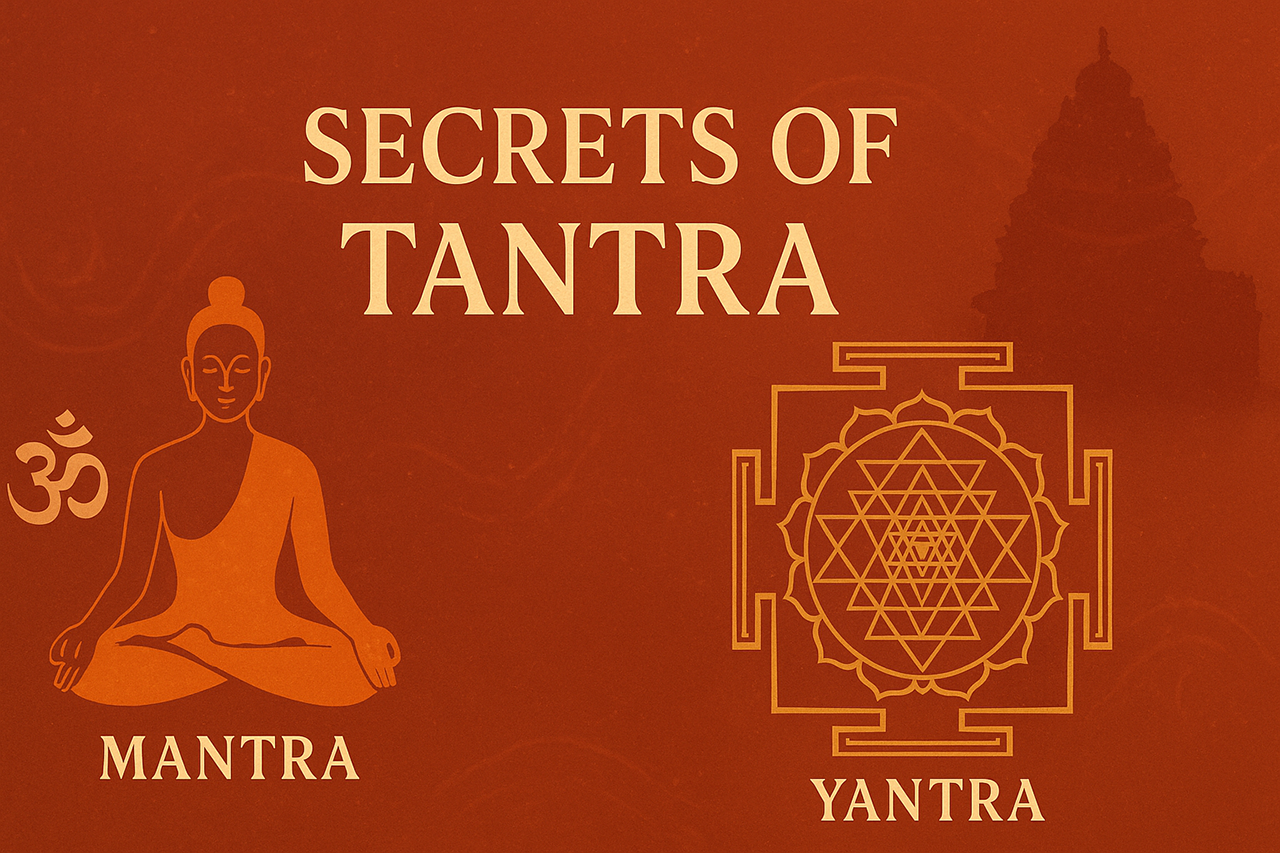India’s spiritual heritage is a vast ocean of practices and philosophies. Among its most mystical and powerful concepts are Tantra, Mantra, and Yantra. Though often misunderstood or used interchangeably, each of these has a distinct identity and purpose. Together, they form a sacred triad used in various yogic, tantric, and Vedic rituals to attain spiritual progress, healing, and transformation. ( Secrets of Tantra , Mantra and Yantra)
What is Tantra? (Secrets of Tantra)
✦ Definition:
Tantra (from Sanskrit “tan” meaning “to expand” and “tra” meaning “instrument”) refers to a system of esoteric spiritual practices aimed at expanding consciousness and achieving spiritual liberation, often by harnessing the divine energy inherent in the body and universe.
✦ Philosophy:
Tantra is both a scriptural tradition (composed of Tantras and Agamas) and a practice-based path. It emphasizes Shakti (divine feminine energy), kundalini awakening, rituals, chakras, and sometimes unconventional methods to transcend duality.
✦ Key Aspects:
- Focuses on experience over theory
- Integrates body, mind, and spirit
- Reveres both the masculine (Shiva) and feminine (Shakti) principles
- Involves rituals, visualizations, meditations, and physical postures
✦ Types of Tantra: (Secrets of Tantra)
- Vama Marga (Left-Hand Path):
- Embraces taboo-breaking rituals
- Involves elements like alcohol, meat, and sexual rites (in symbolic or literal forms)
- Used to dissolve societal conditioning and ego
- Dakshina Marga (Right-Hand Path):
- More ascetic and symbolic
- Rituals are internalized (e.g., meditative visualization)
- Popular in many Hindu and Buddhist tantric schools
- Kaula Tantra:
- Focuses on the body as a temple
- Involves the worship of Kundalini and chakras
✦ Examples of Tantric Practices: (Secrets of Tantra)
- Kundalini Yoga
- Sri Vidya worship
- Tibetan Vajrayana practices
- Tantric pujas involving deity invocations
✦ Did You Know?
Some of the earliest tantric texts date back to the 5th century CE, and Tantrism influenced Hinduism, Buddhism, and Jainism alike.
What is Mantra?
✦ Definition:
A Mantra is a sacred sound, syllable, word, or phrase repeated to focus the mind, invoke spiritual power, or create transformation. The term comes from “man” (mind) and “tra” (tool) — meaning “a tool for the mind.”
✦ Function:
Mantras are vibrational formulas. Chanting them affects the subconscious and alters energy patterns in the mind and body.
✦ Key Aspects:
- Acts through sound vibration (nāda)
- Often used in meditation, rituals, and pujas
- May or may not have literal meaning
- Repetition (japa) enhances efficacy
✦ Types of Mantras:
- Bija Mantras (Seed Syllables):
- E.g., Om, Hrim, Klim, Shreem
- Powerful one-syllable sounds that activate chakras or deities
- Saguna Mantras (With Form):
- Dedicated to specific deities
- E.g., Om Namah Shivaya, Om Namo Narayanaya
- Nirguna Mantras (Formless):
- Focus on abstract or formless Brahman
- E.g., So’ham, Aham Brahmasmi
- Vedic Mantras:
- Found in the Vedas
- E.g., Gayatri Mantra, Mrityunjaya Mantra
- Tantric Mantras:
- Used in Tantric rituals and sadhanas
- Require initiation (diksha) for safe and effective use
✦ Example:
Gayatri Mantra
“Om Bhur Bhuvah Swaha, Tat Savitur Varenyam,
Bhargo Devasya Dhīmahi, Dhiyo Yo Nah Prachodayāt.”
— A prayer for divine illumination
✦ Did You Know?
Modern neuroscience supports that mantra chanting can lower stress, improve focus, and activate brain regions associated with well-being.
What is Yantra?
✦ Definition:
A Yantra is a sacred geometrical diagram used for worship, meditation, and invocation. It is a visual counterpart to a mantra and is believed to be the body or home of the deity it represents.
The word “Yantra” comes from “yam” (to control) and “tra” (instrument), meaning an instrument of control or concentration.
✦ Function:
- Focuses the mind during meditation
- Channels and magnifies energy
- Acts as a symbolic representation of cosmic principles
✦ Key Aspects:
- Often consists of interlocking triangles, lotus petals, circles, and bindus (dots)
- Used in temples, altars, and personal meditation spaces
- Energized through ritual (prana-pratishtha)
✦ Types of Yantras:
- Sri Yantra:
- Most famous; represents the universe and divine feminine (Tripura Sundari)
- Nine interlocking triangles around a central point (bindu)
- Shiva Yantra:
- Used to worship Lord Shiva
- Features trishula-like or triangle motifs
- Kali Yantra:
- Represents transformation and destruction of ego
- Lakshmi Yantra:
- Invokes prosperity and abundance
- Planetary Yantras:
- Navagraha yantras for astrological remedies
✦ Example: (Secrets of Tantra)
Sri Yantra
- Said to be over 12,000 years old
- Used for attracting wealth, harmony, and spiritual ascent
✦ Did You Know? (Secrets of Tantra)
The Sri Yantra’s geometry has been studied by mathematicians and is believed to be structurally aligned with quantum patterns and even the golden ratio.
How They Interconnect (Secrets of Tantra)
- Mantra is the sound or vibration
- Yantra is the form or visual representation
- Tantra is the philosophy or practice that uses both
A practitioner may meditate on a yantra while chanting a mantra, as prescribed by a tantric ritual. Together, they form a holistic spiritual technology.
Conclusion (Secrets of Tantra)
Tantra, Mantra, and Yantra are not isolated esoteric tools but deeply interconnected pathways for self-realization and empowerment. Whether you seek inner peace, divine connection, or mystical insight, understanding these elements can elevate your spiritual practice to a profound new level.
As you explore:
- Approach Tantra with reverence and proper guidance
- Chant Mantras with devotion and clarity
- Meditate on Yantras with focus and understanding
Let this trinity guide you from the mundane to the mystical, from the outer world to the inner self.
May your journey be blessed with clarity, power, and awakening.
Similar Blogs



